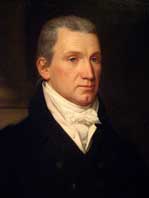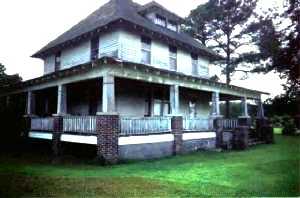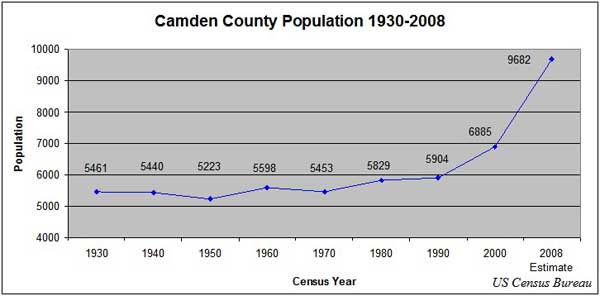After the Revolutionary War, the residents of Camden built a courthouse, jail and stocks in 1782 on property obtained from Thomas Sawyer at about the same spot of the present-day courthouse. There have been three courthouses and three jails located on this spot over the past 200 years. The wooden courthouse built in 1782 burned in 1846, thus a new brick one was built in 1847 and it served Camden until 1996. A new courthouse annex built in 1997 serves the county today.
The first jail was used until the 1880's; after which, a second jail was constructed. This one burned in 1910 as a result of an attempted prison escape. The third jail was built in 1910 at a cost of $6250. Services of this jail were discontinued in the 1940's when Camden began sending its prisoners to Pasquotank jail. Today, the tri-county (Pasquotank, Camden and Perquimans) jail houses prisoners from Camden.
The third jail, a two-story structure, has been restored to its original appearance. The first floor now houses the Board of Elections. The second floor has the original bull-pen containing 4 cells. Also on the second floor is a small museum which uses pictures and artifacts to relate the history of Camden. Outside, stocks and a pillory have been rebuilt to show punishment used in the 18th Century.
Click to Enlarge
While George Washington was president, construction began on the Dismal Swamp Canal. It began in 1793 and ended 12 years later in 1805. The construction of the canal proved to be one of the biggest events to take place in Camden County.
Boating and Kayaking on the Dismal Swamp Canal 205 years after completion of it's construction.
Click to Enlarge
In 1818, President James Monroe stayed overnight at the Farange Hotel near the present-day Dismal Swamp Welcome Center and also at the home of Enoch Sawyer at the Pecan Farm. He was the only known President to stay overnight in Camden.


President James Monroe and the Historic Home of Enoch Sawyer
where President Monroe once stayed.
Life was simple in the late 1700's. When the first census was taken in 1790, Camden had a population of approximately 4100. Camden's population grew to 6733 in 1830, but by 1840, it had dropped to 5500. This population number was to remain fairly constant for the next 160 hears. Only in the year 2001, did the population of Camden surpass 7000.
[Editor's Note: From 1930 to 1990, there was a steady increase in population leading to a total population of 5904 in 1990, and then in 2000 the US Census Bureau reported a population total of 6885 for Camden County. The latest population estimate for Camden County from the US Census Bureau is 9682 residents living in Camden County for calendar year 2008.]
 Population Statistics from US Census Bureau 1930-2008
Population Statistics from US Census Bureau 1930-2008
In 1923, the building of the "Floating Road" was hailed by the Elizabeth City Daily Advance with the statement, "Camden may henceforth retain her own name, but from hence forth and forever in everything except name she is one with Pasquotank." Then in 1941, the Huffman Company began construction on the "Camden Causeway" by pumping 899,000 cubic yards of sand to create a 3 mile causeway to link Camden and Pasquotank counties.
Click to Enlarge
Even though Camden has close ties and shares many services with Pasquotank, Camden is proud to be a small county. Camden County is the first and only consolidated city-county in the State of North Carolina, and it's county seat is the Courthouse Township of Camden. Camden County achieved this status in June of 2006, and became a Unified Government as of July 1, 2006. Camden residents take pride in their rural population, school system, and county government and they look forward to its future in the 21st Century.
